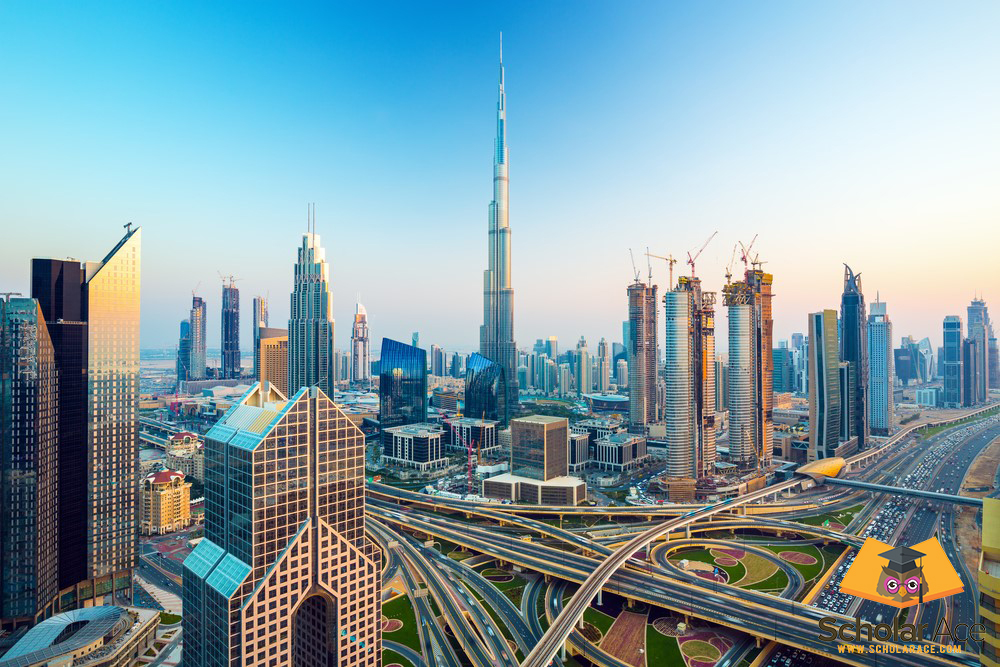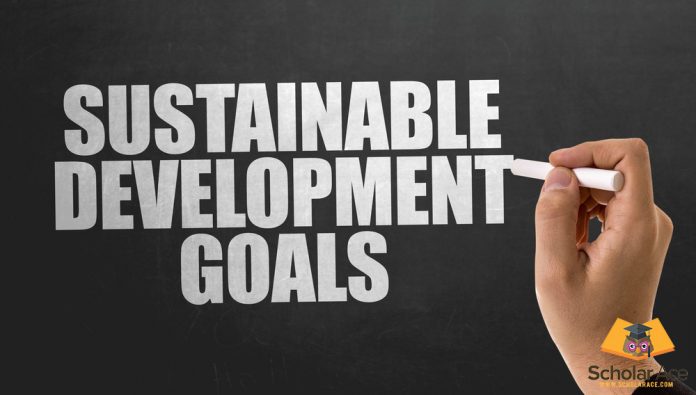Table of Contents
What Are Sustainable Development Goals?
Sustainable Development Goals (SDGs), also popularly called Global Goals, are worldwide appeals to act to protect the planet, end poverty and make sure that people enjoy prosperity and peace globally.
All these 17 goals are built on the accomplishments of the Millennium Development Goals, whilst adding in new areas like justice, sustainable consumption, innovation, economic inequality, climate change amongst other primacies. These goals are interrelated –usually achieving one goal involves dealing with problems that are more commonly linked with another.
Sustainable Development Goals Of THE UAE
The United Arab Emirates has been a strong promoter for the construction of 2030 Agenda and there’s no denying that the country’s pledge to sustainable development is its key vision for the years to come. The thoughts of UAE’s sustainable development spread throughout its national development plan – the ideas of its seven Emirates and Vision 2021.
As of now (2019), Dubai has accomplished a major part of UAE’s sustainable development goals which come under the SDG 11 (making human settlements and cities sustainable, safe, resilient and inclusive) of the united nation’s 2030 agenda.
In a board dialogue named ‘Sustainable and resilient cities: opportunities and policy challenges to building smart cities,’ the UN saw Dubai’s huge accomplishments as a city in the areas basic services (like authorized electricity, 100% portable water alongside sustainable access to much better sanitizing facilities and water sources), transport and healthcare whilst also highlighting other developmental goals of the future.
Learn More: THE 17 GOALS | Sustainable Development
Sustainable Development Goals – UN 17 SDG list
One example can be witnessed in housing sectors, where all properties and lands are documented title contracts in the government and 0% of the people reside in slums.
Undoubtedly, the UAE has one of the finest public sectors globally- one that is underpinned by a thorough and orderly performance framework, operates in transparent and open way, one that has highly innovative and effective tools for delivering public services and furthermore comes with skilled civil services.
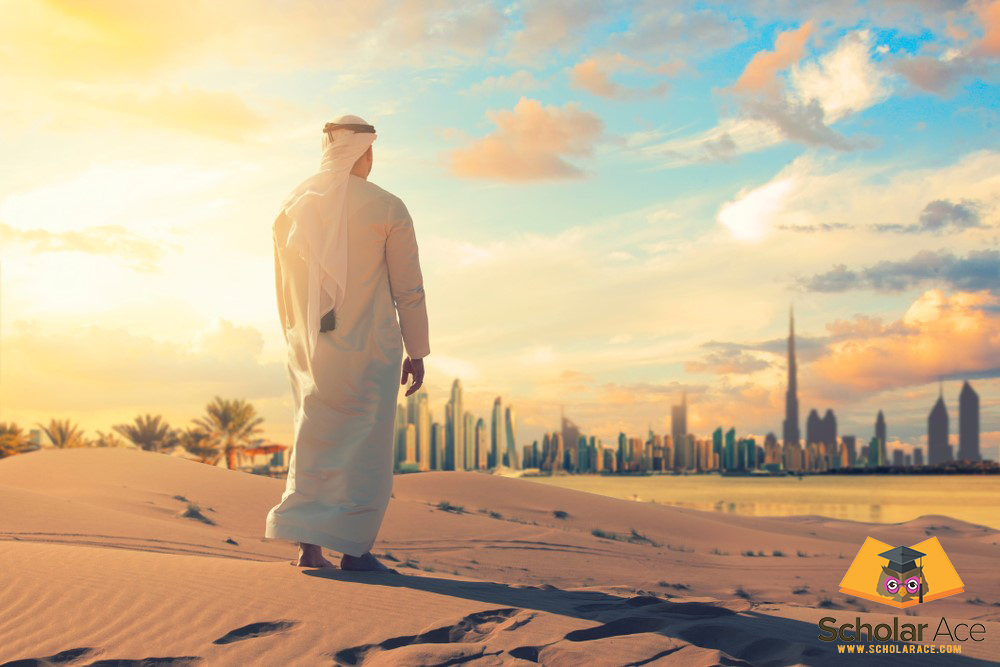
Introduction
This study is aimed at providing an insight into one of the major sustainability development goal of the United Nations which is industry, innovation, and infrastructure. Sustainability Development Goals of UN provide a wide platform for the transformation of this world into a better place and to achieve sustainable development in all parts of the world. 2030 Agenda of UN provides a detailed description of seventeen different goals of SDGs. All of the goals are interdependent and these include 169 different targets along with the measurement of 232 indicators of success. Goal 9 of the SDGs is selected to find out how it’s implemented in different parts of UAE for the development of infrastructure and to instill innovation in industry. this goal of the UN reflects that there is a need to build such a type of infrastructure which would be resilient, foster innovation, and to promote sustainable and inclusive industrialization in all parts of the world. This goal reflects that manufacturing is one of the main source of employment.
As UAE is one of the strong economy of the world and it is considered as one of the most successful business center of the world. Government of the UAE has also included SDGs in its planning and development process. UAE is also considered as a regional leader in developing industrialization, building infrastructure, and pioneering innovation. Government of UAE has also laid pressure to consider SDGs as key elements for the sustainable progress. Visionary leaders of the UAE also announced number of policies and initiatives for the implementation of goals related to innovation, industrialization, and infrastructure development. Use of major aspects of Goal 9 of SDGs in various infrastructure and innovation project of UAE are discussed in this report. This study also considers Dubai 3D Printing Strategy which will reflect how innovation and industrialization are merged for the promotion of new technology.
Objectives and Targets
As SDGs were formulated in 2016 and these are based on extensive research about the growth and development patterns of different regions of world so these are capable of improving manufacturing per capita of developing economies of world. Least development countries are also considered while implementing those goals and objectives. There are number of objectives and targets of the sustainable development goal 9 as:
- Development of such a type of trans border and regional infrastructure which is reliable, resilient, possess quality, and sustainable. Such infrastructure would be also capable of supporting economic development and provide equitable access to all regions. Well being of human is also considered as one of the priority in this goal,
- Promotion of sustainable and inclusive industrialization, and there would be an increase in the industry share of gross domestic product and employment, and it is also aimed at to double the share of growth in the least developed countries of world.
- There shall be an access of small and medium enterprises and small scale industries in the developing countries of the world. Financial services and provision of affordable credits along with the integration of markets and chain values is also included in objective of SDGs Goals.
- Up-gradation of infrastructure sustainability of industries to improve efficiency of resources and to adopt such a type of technology which would be able to achieve environment protection goals and to improve production capabilities.
- Enhancement of technology and scientific research in all industrial sectors at global level which would encourage sustainable development and innovation and to also increase manpower efficiency.
- Technical, financial, and technological support will be provided to developing countries to ensure development of resilient infrastructure.
- Development of domestic technology shall be also supported to improve research and innovation in developing countries and a conducive policy shall be also implemented for commodities value addition purpose and to increase industrial diversification.
- Communication systems shall be also based on strong platform and smooth flow of communication shall be ensured and affordable and universal access will be also provided in the least developed countries of the world by the end of 2020 (Jezard, 2018) .
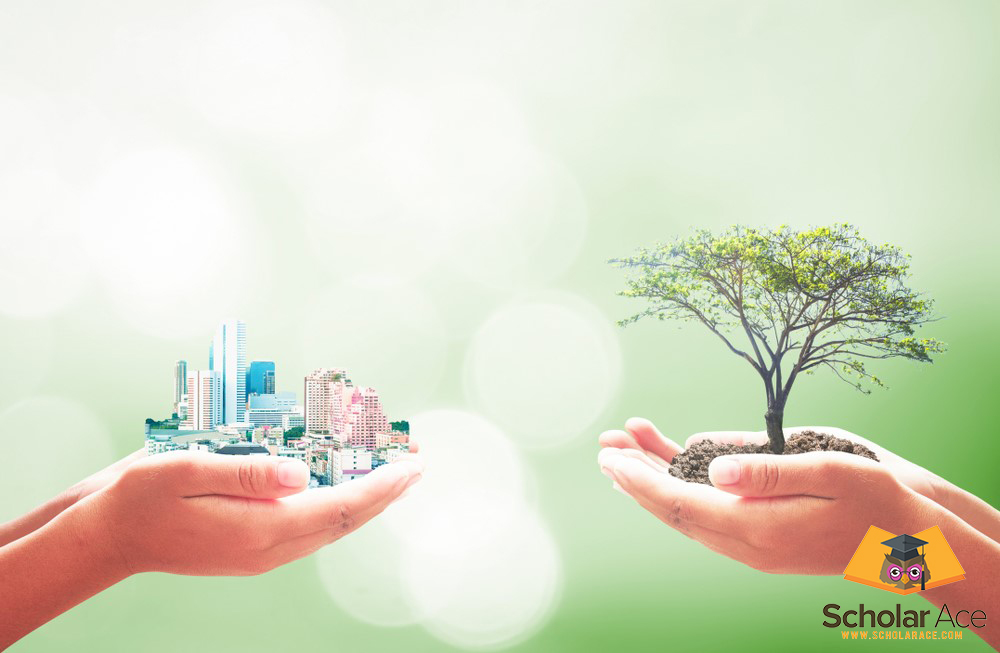
There are also indicators of the Goal 9 which include consideration of manufacturing value added as a part of the total employment. Transport modes shall be improved to set freight volumes and to improve services for passengers. Emission of CO2 shall be also controlled per unit of the added value. Research and development expenditure is proportion of gross domestic product and technology in the form of mobile networks covering proportion of population. These indicators provide a global framework for the achievement of sustainable development.
Progress of the goal 9 of SDGs is also provided by UN and it shows that manufacturing industry is making steady progress and it is promoting industrialization, level of employment, and help economic forces to attain competitive edge in international market. It is found that there is a 16.3% increase in the GDP in 2017 due to value addition by global share of manufacturing as compared to 2005 in which it was about 15.2%. There is also a decline in the intensity of carbon by 19% in 2015 since 2000. It is also found that 84% of the population is covered by third generation mobile networks at global level and 3G networks covered 61% in the least developing countries of the world. Innovation and upgradation of the transportation services has also created number of opportunities for the employment and it has also drove economic development at global level. social stability is also enhanced due to improved manufacturing industry. there is also an increase in investment in research and development and it has increased by 1.7% in 2014 at global level (Baldwin, 2018) .
Industry, Innovation and Infrastructure in UAE
Government of UAE has initiated number of projects for the achievement of Goal 9 of SDGs of UN and these projects helped in improving infrastructure, industrialization and innovation. UAE has also hosted one of the major event i.e. Industry, Innovation and Infrastructure in UAE which was scheduled in Abu Dhabi in 2017. This summit was one of the main source which provided a solid evidence for the focus and determination of government of UAE to promote innovation and growth in the country. There were more than 1200 representatives of different global governments. They also belonged to various industries, academia, students, and civil societies. Main focus of the summit was skills, employment, innovation, capital markets, infrastructure, policy, environment, and society. This summit also provided number of policies which are capable of bridging the gap between advanced and emerging nations to ensure growth and development at global level.
This study has considered one of the major projects of UAE government which was introduced to achieve innovation, infrastructure, and industry development goals in UAE. This project is related to the launching of Dubai 3D Printing Strategy in 2016 by H. H. Sheikh Mohammed. This initiative was aimed at promoting technology which would provide services for the humanity and would help UAE to increase share of its growth and development at international level as Dubai is a leading technology hub of the UAE and it is focused in promoting 3D printing technology in all markets of UAE by the end of 2030 (GAROFALO, 2018) .
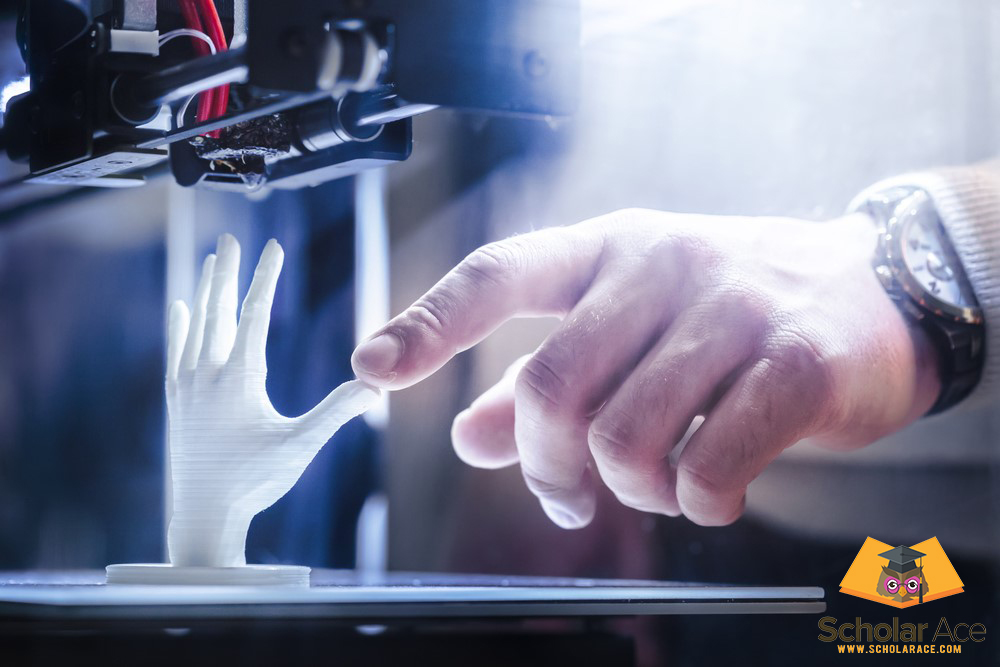
Dubai 3D Printing Strategy
Dubai 3D Printing Strategy was launched in 2016 and this strategy is aimed at making Dubai as a leading hub of the printing technology for 3D by the end of 2030. 3D printing is considered as one of the main source of improving humanity. This project is aimed at making 25% of the buildings in state will be based on 3D printing by 2025. This strategy is aimed at reducing labor by 70% and reduces costs by 90% in different sectors of economy. This project will be capable of solving various economic issues like homelessness crisis and it will be also help in the development of 41 mega cities of the world which will be helpful in providing habitat to 10 million people. There are three main sectors which will be covered by this project i.e. construction, medical products, and consumer products. And this project is based on five main pillars i.e. talent, market demand, funding, infrastructure, and legislative structure. This project is also aimed at considering construction joints, lighting products, foundations and basis, parks and facilities, and mobile homes (Anon., 2019).
Past Example and Status
3D printing strategy has helped manufacturing and technological sector of the UAE to grow at rapid rate and to reduce extra costs which are incurred on labor and other overheads costs. There is 9% of the GDP provided by manufacturing sectors of UAE and it has indicated that use of upgraded 3D technology has helped in improving growth and development of the manufacturing and construction sector of UAE. And activities which are based on 3D printing are capable of increasing GDP by 1%. Global economy of the UAE was $80 million in 2017 in which about 16% was contributed by manufacturing sector of the country which amounted to $12.8 trillion. Direct manufacturing of the UAE economy was $350 billion and it amounted to $350 billion. And manufacturing sector of the economy contributed about 9% in the direct manufacturing of the UAE. Such an increase in the manufacturing sector is due to implementation of 3D printing technology in manufacturing and construction sector of the country. It has also helped in digitization of inventories. And it is analyzed that global inventory has been more than $10 trillion in 2017 in which about 5% increase was due to usage of 3D printing strategy (DIAZ, 2018).
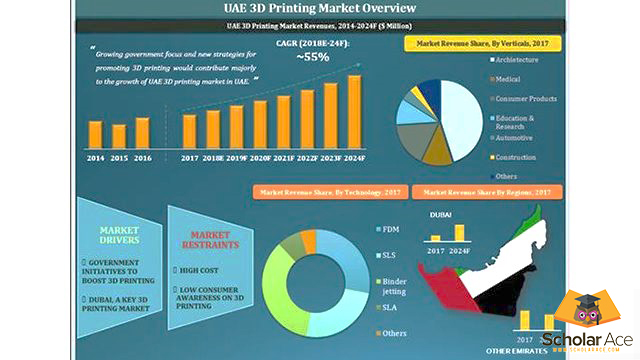
Figure 1 indicates contribution of 3D Printing strategy in the market revenue share of the country. It is found that this strategy has contributed in the upgradation of medical, construction sector, automotive, architecture, consumer products, education and research, and other building blocks of the economy. Binder jetting and SLA are also improved by the implementation of this new technology. Government of UAE has taken several steps to boost 3D printing technology in the market. There is a gradual increase in the growth of manufacturing, construction, and medical sector of economy of UAE. And it is also predicted that it will be also helpful in increasing market share at international level. (Gov, 2019)
Present Status
Currently 3D printing technology is implemented at wider level and it is also increasing growth prospects of the country. Research has also indicated that world’s first 3D printed office building is present in Dubai and it is printed in seventeen days and it construction is completed in 48 hours. This office is fully operational and it is located in iconic Emirates Towers of Dubai. This office is fully operational. This office is about 6 meters in height, 12 meters in width, and 36 meters in length. This method of construction is quite faster than traditional method of construction and architecture. 3D printing method of construction required one person to monitor functioning process of the printer, and seven people were needed to install various components of the building. A team of ten specialists and electricians was needed to take care of the electrical and mechanical engineering requirements of the office. Office building based on 3D printing strategy is reflected in Figure 2.
It is also estimated that total costs incurred on this project was $140,000, and this type of the construction method helped in cutting costs to a greater extent and cost of the labor and cost of the building was reduced by more than 50% as compared to the cost incurred in traditional ways of manufacturing and construction. There is more enhancement in the productivity of economy and higher economic returns are also achieved and sustainability development is also increased to a greater extent.
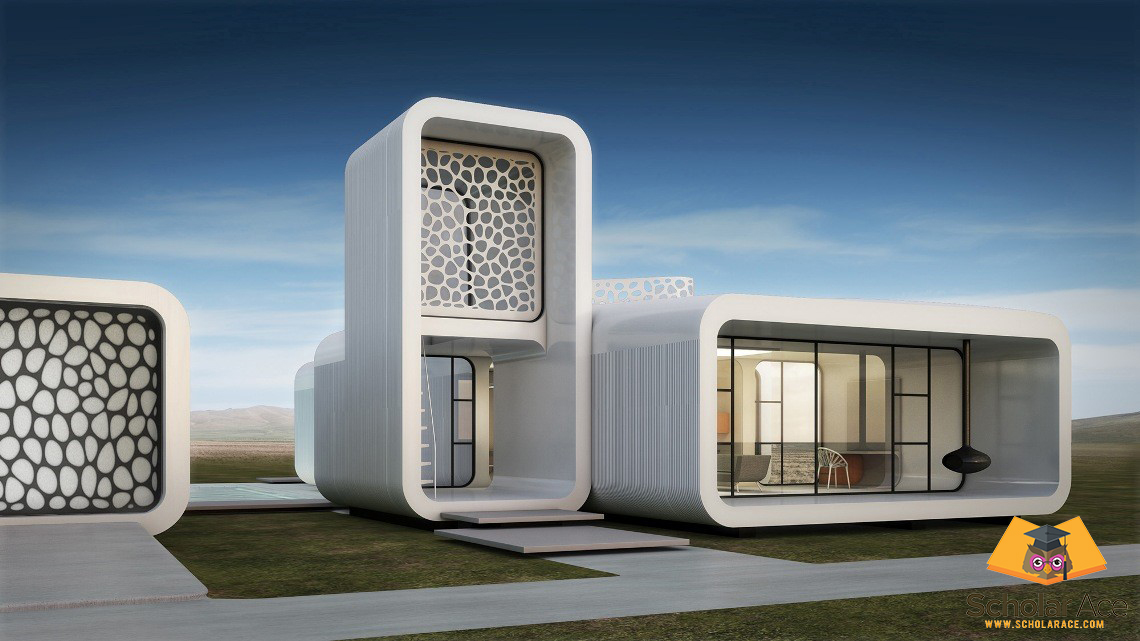
3D printed office was constructed by using special type of building materials and mixture of cement which was also designed in UAE. Office was based on arc shape which is capable of providing safety and stability to the building structure. It is also analyzed that such a type of projects is carried out at wider scale after the successful completion of project to build first 3D printing based office, and it is also helping to transform traditional ways of construction into more innovative and cost saving methods. These methods are also capable of improving communication between the teams and it has also provided a strong base to reduce consumption of the energy as such a type of office is protected from direct sunlight and there is efficient cooling of building.
One of the famous high tech Chinese technology enterprise i.e. WinSun Global and Dubai government has formed a partnership for the development and research on 3D based offices. And this office is also resulted from the joint efforts of both of these parties. Syska Hennessy and Gensler, Thornton Thomasetti who are leading engineering firms and global architectures are also involved in this construction process. This project has provided a strong base to achieve Goal 9 of the SDGs which is aimed at promoting innovation, technology, and infrastructure.
Future Plans to Initiate and Sustain the Project
There are number of future plans which are aimed at building 25 % of the infrastructure of UAE on the basis of 3D printing by the end of 2030. It is also estimated that these projects will take only 10% of the total time which is taken by traditional ways of construction. It is also analyzed that there are forecasts for the achievement of $120 billion by the end of 2020 by global market of 3D printing. And it will be increased to $300 billion in 2025. There will be more ease in using production processes as these will be able to design and manufacture desired products in a minimum time period. It is also assessed that construction cost will be cut by 50% to 70% and there will be also reduction in labor costs by 50% to 80% in near future. Waste production will be also controlled by using 3D office building strategy which will help in achieving high economic returns and to improve environmental sustainability. (BENNETT, 201)

Consumer products sector will be also focused by using 3D printing strategy and different types of the household items, children games, fast food, optics, and fashion jewelry is expected to be able to generate 2.8 billion Dirhams in the market by 2025. Medical products sector will be also aligned with the goals and objectives of 3D printing and it will help in developing artificial organs, surgical and medical devices, printed teeth, and hearing aids. Figure 3 indicates forecasts for the implementation and expected cost savings in the UAE market based on 3D office printing.
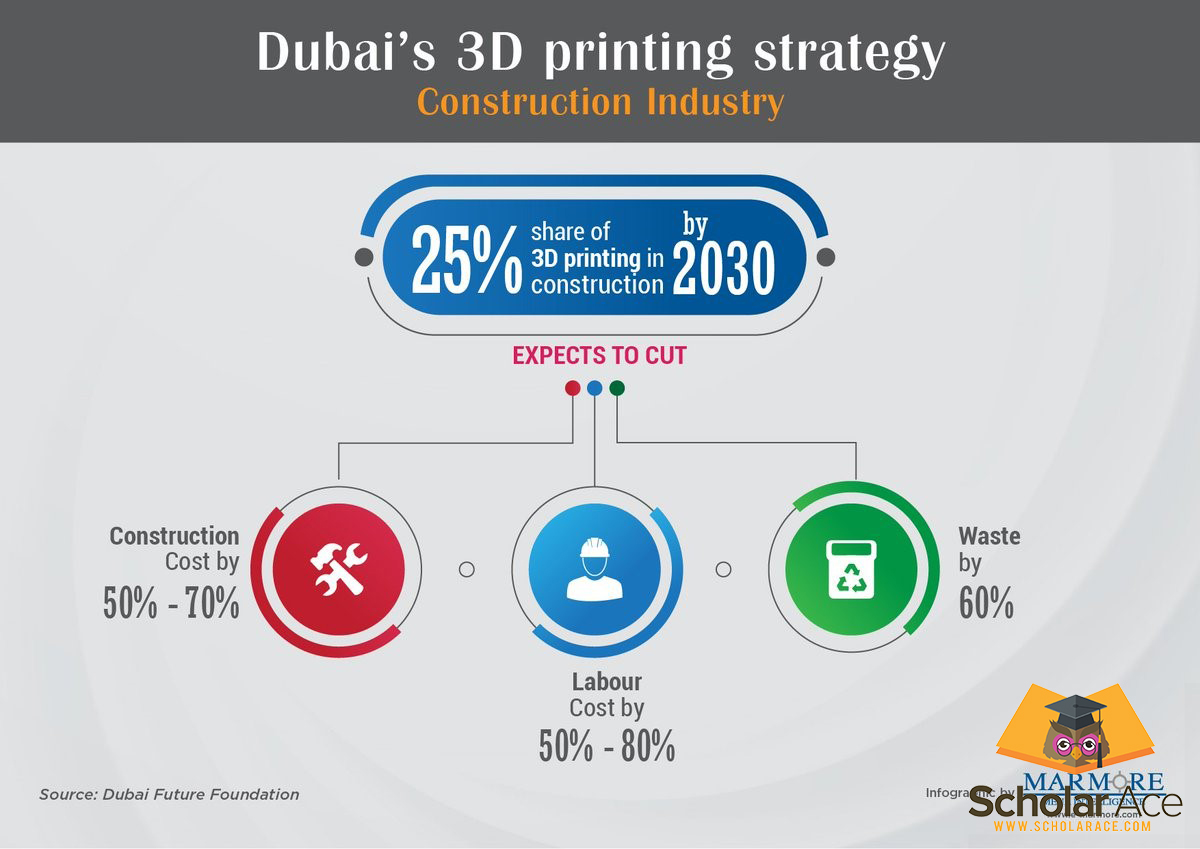
Analyze Factors That Determine Sustainability of the Goal 9- Industry, Innovation, and Infrastructure
There are number of factors which contribute to the achievement of sustainability in innovation, industry, and infrastructure. These factors include social, economic, political, and environmental factors which help in the promotion of sustainability. These factors provide basis to develop sustainable infrastructure. Social factors include acceptance of innovative projects and infrastructure in the society. This factor is also aimed at promoting such a type of innovations, developments, and industry which would be able to serve community and secure it to achieve high level of sustainability. It is also helpful in the alignment of those SDGs goals with the social perspective. Employee retention and customer satisfaction are also some of the important parts of sustainability which can help in achieving those SDGs goals more efficiently. Social factors also provide number of opportunities to improve growth and development of infrastructure and industry (Report, 2017).
Political factors also contribute to improve sustainability of the Goal 9 of SDGs, as political situation of the UAE is capable of providing vulnerable environment for the promotion of innovation, industrialization, and infrastructure in different states of the country. Environmental factors also play an important role in the achievement of sustainability as it provides a strong platform to reduce packing wastage, carbon foot prints, and water usage. There is also a beneficial impact on the environment which in turn has a positive impact on the financials. Zero waste initiative will be also carried out which will help in achieving sustainability goals. Environmental hazards can be also reduced and there can be an improvement in innovation projects. Economic factors are also capable of improving sustainability of innovation, infrastructure, and industrialization. These factors provide a ground to increase profits and reduce costs. Sustainability strategies are also improved and these increase profits of business and encourage innovation. Risk management strategies and proper governance can be easily achieved by considering those factors (BEATTIE, 2017).
Evaluation of Environmental Impact of Industry, Innovation and Infrastructure in UAE
Industry, innovation, and infrastructure has provided a strong platform for the improvement in economic and development aspects of the country. As UAE is one of the leading economy which is capable of meeting all the requirements of globalization and goals of the SDGs. As government of the country has also implemented number of strategies for the Green Economy and UAE Green Agenda is formulated for 2015-2030. Green Agenda of UAE is based on green energy, green investment, green city, green life, climate change, and green technologies. It is analyzed that Green Agenda of the UAE can be achieved by using Goal 9 of the SDGs. Industrialization, innovation, and infrastructure development is aligned with the Green Agenda and it is leading to the protection of environment and to reduce extra wastes and improve resource usage process. Social development can be also achieved in more effective ways by using these goals and environmental sustainability can be also improved which leads to the efficient usage of valued natural resources. Environmental protection goals and objectives also help in reducing pollution and these help in improving green economy. (Anon., 2017)
Conclusion
This study has provided an insight into one of the main goal of Sustainable Development Goals of UN i.e. Goal 9 which is Industry, Innovation, and Infrastructure. Government of UAE has taken several steps for the implementation of such a type of strategies which can promote industrialization, innovation, and infrastructure development. This study has analyzed 3D Printing strategy which is implemented by the government of UAE and one of the Chinese hi-tech firms in Dubai and world first 3D printing office is built and designed in recent years which is reflection of innovation, and updated technology. This project helped in saving costs and promoting profits along with the consumption of minimum time period as compared to the traditional ways of manufacturing. This project has provided evidence that how government of UAE is implementing various projects for the promotion of industrialization, innovation and upgraded infrastructure development.
